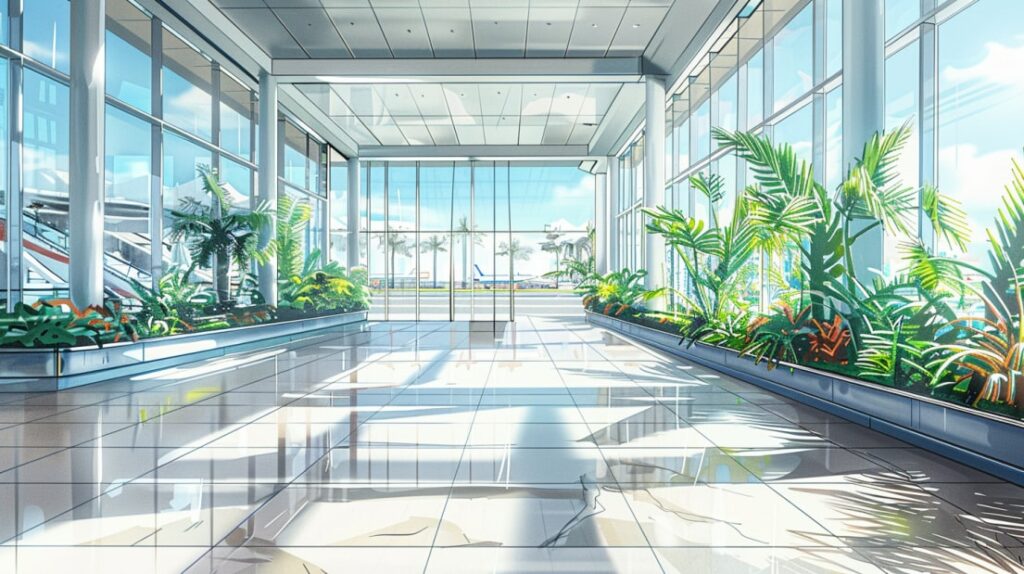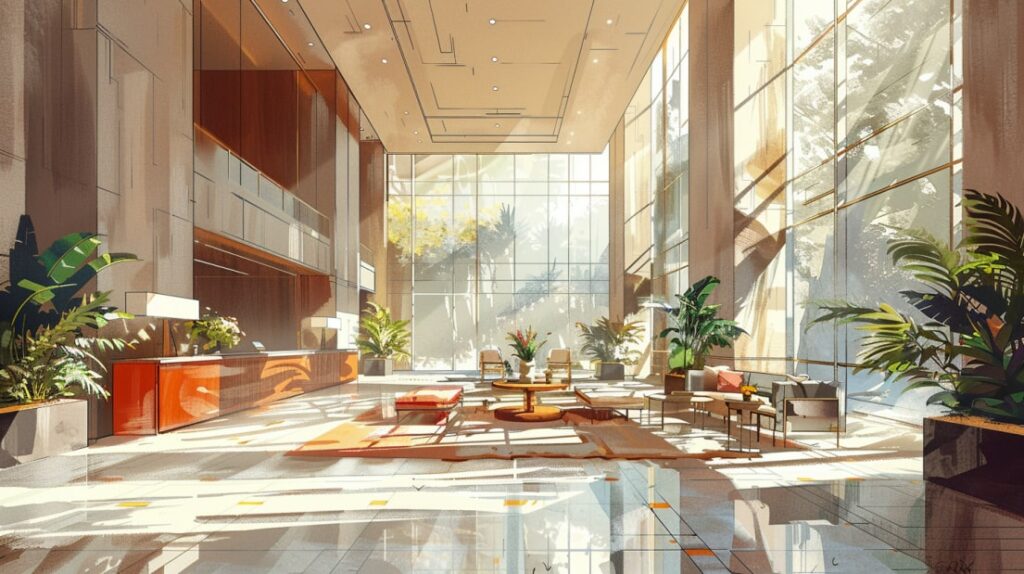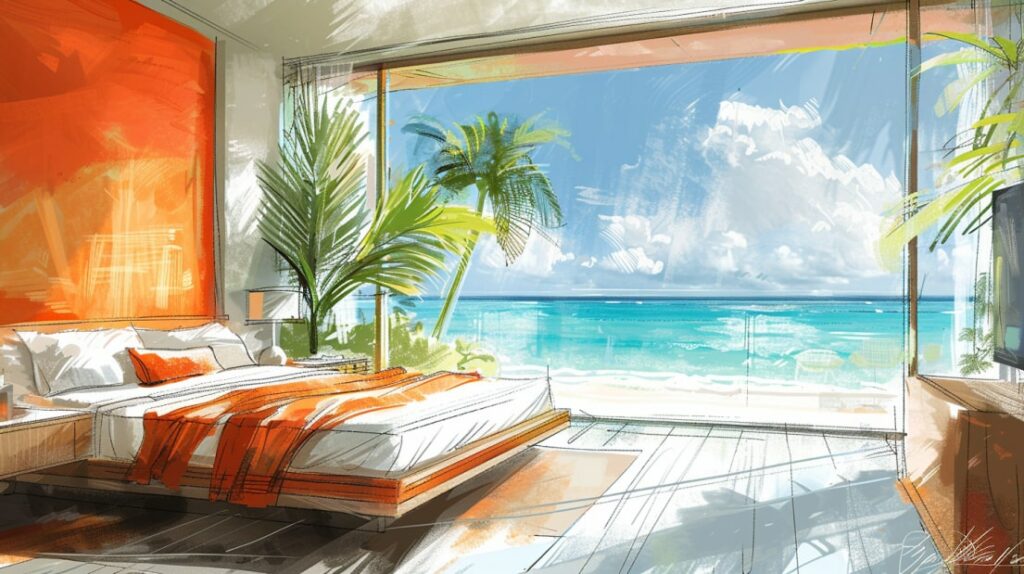Unlock Premium, Members-Only Content
Your source for the most relevant updates in sustainable construction
Welcome to the world where design meets sustainability, and where your living space doesn’t just look good—it does good. Dive into the heart of green interior design, where every choice is about enhancing life, respecting our planet, and styling our spaces in harmony with nature.
Introduction to Green Interior Design
Green interior design isn’t just a trend; it’s a commitment to making environmentally responsible and resource-efficient decisions throughout the design process. It’s about creating spaces that are not only aesthetically pleasing but also healthy for the occupants and the planet.
The Psychology of Green in Interior Spaces
The Impact of Green Interior Design
Imagine stepping into a room filled with light, natural textures, and a palette inspired by the outdoors. How does it make you feel? Calm, refreshed, perhaps even inspired? That’s the psychological power of green in interior spaces. Studies suggest that rooms with elements of nature or greenery can boost mood, increase creativity, and even improve air quality. It’s not just about the color green, though that plays a significant part, but also about integrating natural materials, plants, and maximizing natural light.
Color Me Happy
Green hues, from sage to forest, have a unique place in our psyche. They remind us of nature, which inherently makes us feel more relaxed and at ease. Incorporating green through walls, décor, or plant life can transform the energy of a room, making it a peaceful refuge in our hectic lives.
Fundamental Principles of Green Interior Design
The Triple R Approach
Sustainable design is built on a simple yet powerful foundation: Reduce, Reuse, Recycle. Let’s break it down:
- Reduce: Minimize waste by choosing products and designs that require less material and energy to produce.
- Reuse: Opt for items that can be repurposed, giving them a new life in your design scheme.
- Recycle: Incorporate materials that can go back into the manufacturing cycle, reducing the need for virgin resources.
Energy Efficiency and Beyond on Green Interior Design
Energy efficiency is the star of the green design show. Choosing appliances and lighting that use less energy not only cuts carbon emissions but also saves money. But sustainable design doesn’t stop there. It extends to water conservation, using low VOC materials to improve indoor air quality, and selecting furnishings that are made to last.
| Principle | Description | Examples |
|---|---|---|
| Reduce | Lower the environmental impact by minimizing resource use. | LED lighting, energy-efficient appliances |
| Reuse | Incorporate items that can have a second life in your design. | Vintage furniture, repurposed materials |
| Recycle | Use products that can be recycled at the end of their lifecycle. | Recyclable carpets, modular furniture |
Material Selection for Green Interiors
Choosing the right materials is crucial in green interior design. It’s not just about looking good—it’s about being good to the earth. Here are some top picks:
- Bamboo and Cork: Fast-growing and sustainable, these materials are stars in eco-friendly flooring and furniture.
- Recycled Metal and Glass: Sleek, modern, and infinitely recyclable, these materials add a clean, industrial edge to spaces.
- Low VOC Paints: Keep your air quality as fresh as your walls with paints that don’t off-gas harmful chemicals.
Go Natural or Go Home
Incorporating natural materials isn’t just a style choice; it’s a health choice. Materials like organic cotton, wool, and natural latex not only reduce synthetic chemicals in your home but also bring an unbeatable warmth and texture to spaces.
This dive into the beginnings of green interior design is just the tip of the iceberg. With the foundations laid out, the journey into sustainable, healthy, and beautiful living spaces is just beginning. Stay tuned as we explore more ways to bring the principles of green design into every corner of your home.
As we delve deeper into the world of green interior design, we find ourselves at the intersection of innovation, creativity, and environmental stewardship. The journey continues as we explore energy-efficient lighting and appliances, water conservation techniques, and the ever-important incorporation of biophilic design principles.

Energy Efficient Lighting and Appliances
Lighting Up the Green Way
The quest for sustainability brings us to the forefront of lighting technology. LED bulbs are the heroes here, using up to 75% less energy and lasting 25 times longer than traditional incandescent bulbs. But it’s not just about swapping out bulbs. It’s about rethinking how we illuminate our spaces—maximizing natural light through strategic window placement and reflective surfaces, and employing smart lighting systems that adjust to our needs, reducing waste and conserving energy.
Appliances That Save More Than Just Time
In the heart of the home, energy-efficient appliances play a pivotal role in reducing our carbon footprint. Look for the ENERGY STAR label—a symbol of energy efficiency and savings. These appliances, from refrigerators to washing machines, are designed to use minimal electricity and water, helping you reduce your bills and your impact on the planet.
Water Conservation Techniques
A Drop Saved is a Drop Earned
Water conservation in interior design isn’t just about fixing leaks. It’s about integrating fixtures and systems that use less water without sacrificing performance. Low-flow toilets, showerheads, and faucets can significantly reduce water usage. For the more ambitious, greywater systems reuse water from sinks, showers, and washing machines for irrigation, turning waste into a valuable resource.
Incorporating Biophilic Design
Bringing the Outside In
Biophilic design reconnects us with nature, creating spaces that are alive with greenery, natural light, and organic materials. It’s not just about placing a plant on a windowsill; it’s about integrating nature into the very fabric of our spaces. Living walls, indoor gardens, and natural materials like wood and stone not only improve air quality but also our mental and physical well-being. This design philosophy celebrates the power of nature to soothe, inspire, and rejuvenate.
The Benefits Of Green Interior Design Are Clear
The benefits of biophilic design are backed by a growing body of research. Spaces that embrace natural elements can lead to a remarkable reduction in stress, enhanced creativity, and improved cognitive function. It’s a testament to the fact that when we design with nature in mind, we’re not just making our spaces more beautiful—we’re making ourselves healthier and happier.
This exploration into the green interior design journey reveals the transformative power of thoughtful, sustainable choices in our living and working environments. By embracing energy efficiency, water conservation, and biophilic design, we can create spaces that are not only environmentally responsible but also deeply connected to the well-being of their inhabitants. The path towards a more sustainable future is illuminated by innovation and inspired by nature, leading us towards a harmonious blend of design and sustainability.
Continuing our deep dive into the essence of green interior design, we now explore sustainable flooring options, eco-friendly wall treatments, and the significance of durable, sustainable furniture. This journey not only aims to decorate our spaces but to do so in a way that respects and preserves the environment.
Sustainable Flooring Options
Flooring plays a pivotal role in green interior design, offering both aesthetic and environmental impact. Here are some top choices:
- Bamboo: Grows rapidly and is highly renewable.
- Cork: Biodegradable and provides excellent insulation.
- Reclaimed Wood: Reduces the demand for new lumber and adds character.
- Linoleum: Made from natural materials and is fully biodegradable.
- Recycled Metal Tiles: Durable and can be recycled at the end of their lifecycle.
| Material | Benefits | Sustainability Factor |
|---|---|---|
| Bamboo | Strong and stylish | Highly renewable |
| Cork | Soft and comfortable | Biodegradable |
| Reclaimed Wood | Unique aesthetic | Reduces waste |
| Linoleum | Versatile designs | Natural composition |
| Recycled Metal Tiles | Modern look | Recyclable |
Eco-friendly Wall Treatments and Insulation
Paints and Plasters
Choosing the right wall treatments can significantly affect the environmental friendliness of a space. Low or zero VOC (Volatile Organic Compounds) paints reduce harmful emissions, improving indoor air quality. Natural plasters, such as lime, offer beautiful textures and regulate humidity naturally.
Insulation Matters
Eco-friendly insulation materials, such as sheep’s wool, recycled cotton, or cellulose, not only keep your home warm or cool but also ensure it breathes. They are effective, sustainable, and do not off-gas harmful chemicals.

Sustainable Furniture and Decor on Green Interior Design
Furniture That Lasts
The longevity of furniture is paramount in sustainable interior design. Choosing pieces that are well-made and timeless not only reduces the need to replace them but also means less waste. Look for furniture made from sustainable materials like FSC-certified wood or recycled metals and plastics.
Eco-friendly Decor Tips
- Use vintage or second-hand items: Adds character and reduces demand for new products.
- Select natural fiber textiles: Organic cotton, wool, and hemp are great choices.
- Incorporate plants: They improve air quality and add life to your space.
| Strategy | Description | Benefit |
|---|---|---|
| Vintage/Second-Hand | Reduces demand for new items | Lowers environmental footprint |
| Natural Fibers | Renewable and less toxic | Improves indoor air quality |
| Plants in Decor | Natural air purifiers | Enhances well-being |
Embracing green interior design is more than a trend—it’s a lifestyle choice that benefits us and the planet. From the ground up, every element in our homes or offices can reflect our commitment to sustainability. Whether it’s the materials we choose, the energy we consume, or the furniture we cherish, every decision is a step toward a more sustainable future. The beauty of green design lies not only in its environmental benefits but also in its ability to create spaces that are healthy, vibrant, and harmonious with nature.
As we continue to navigate the realms of green interior design, the focus shifts towards innovative waste reduction strategies, the integration of smart home technologies, and the critical role of certifications and standards in guiding sustainable practices. These facets of design not only contribute to a healthier planet but also pave the way for a more efficient and conscious lifestyle.
Unlock Premium, Members-Only Content
Your source for the most relevant updates in sustainable construction
Waste Reduction and Recycling in Green Interior Design
Reducing waste in interior design is not just about recycling; it’s a holistic approach that encompasses the entire lifecycle of products and materials. Here’s how you can make a significant impact:
- Choose modular furniture: Designed to adapt to your changing needs, reducing the need for replacements.
- Opt for recyclable materials: Metals, glass, and certain plastics can be recycled indefinitely.
- Embrace upcycling: Transform old items into new decor, giving them a second life and unique flair.
Effective Waste Reduction Strategies
| Strategy | Description | Impact |
|---|---|---|
| Modular Design | Furniture that can be reconfigured | Reduces need for new pieces |
| Material Recycling | Using recyclable materials in design | Lowers environmental impact |
| Upcycling | Repurposing old items for new use | Minimizes waste |
Smart Home Technologies for Green Living
Smart home technologies have revolutionized the way we interact with our living spaces, making it easier than ever to reduce our environmental footprint. Here are some game-changing innovations:
- Smart Thermostats: Adjust your home’s temperature remotely and save energy.
- Intelligent Lighting Systems: Control lights via smartphone or voice, reducing unnecessary electricity use.
- Solar Energy Storage: Store excess solar power for use during peak times.
Advantages of Smart Technologies
- Efficiency: Optimize energy use, saving money and reducing emissions.
- Convenience: Manage your home’s environmental systems with ease.
- Adaptability: Integrate with renewable energy sources for a sustainable energy solution.
Certifications and Standards for Green Interior Design
Navigating the green maze can be daunting. Certifications and standards offer a beacon of trust and quality, signaling products and practices that meet rigorous environmental and health criteria. Key certifications include:
- LEED (Leadership in Energy and Environmental Design): A globally recognized symbol of excellence in green building.
- WELL Certification: Focuses on the health and well-being of building occupants.
- GreenGuard: Certifies products for low chemical emissions, improving indoor air quality.
Leading Certifications in Green Interior Design
| Certification | Focus | Benefit |
|---|---|---|
| LEED | Energy and environmental design | Validates sustainability efforts |
| WELL | Occupant health and well-being | Ensures healthy living environments |
| GreenGuard | Low emissions | Promotes better indoor air quality |
The integration of waste reduction strategies, smart technologies, and adherence to established certifications and standards underlines the comprehensive approach required for effective green interior design. By embracing these principles, designers and homeowners alike can contribute to a sustainable future, creating spaces that are not only beautiful and functional but also responsible stewards of our planet. The journey towards green interior design is a continuous one, with each step forward making a difference for our environment and our well-being.
Continuing our exploration of green interior design, let’s delve into the future outlook, emerging trends, and how these advancements promise to further revolutionize sustainable living spaces. As we look ahead, it’s clear that innovation, alongside our evolving understanding of sustainability, will continue to shape the landscapes of our homes and offices.

The Future of Green Interior Design
Innovation and technology are driving the green interior design industry towards more sustainable and efficient solutions. Here are some trends that are set to define the future:
- Biodegradable Materials: The search for materials that break down naturally without harming the environment is intensifying.
- Smart Glass Technology: Windows that can adjust their transparency and insulation properties based on the weather, reducing the need for heating and cooling.
- Indoor Air Purification Innovations: Advanced systems and materials designed to improve indoor air quality more efficiently.
Emerging Trends in Sustainable Design
| Trend | Description | Potential Impact |
|---|---|---|
| Biodegradable Materials | Natural, easily decomposable materials | Reduces landfill waste |
| Smart Glass | Responsive glass technology | Enhances energy efficiency |
| Air Purification | Advanced air cleaning systems | Improves health and well-being |
Integrating Nature with Technology
The convergence of green design and technology not only aims to reduce environmental impact but also enhances our connection to nature. Here’s what to watch for:
- Augmented Reality (AR) for Green Spaces: AR can help visualize green projects before implementation, ensuring optimal use of natural resources.
- Hydroponic and Aquaponic Systems: Soil-less gardening techniques that can be integrated into buildings, reducing water use and allowing for fresh produce.
- Renewable Energy Integration: Solar panels and wind turbines seamlessly incorporated into design, powering homes and buildings sustainably.
Tech-Driven Green Solutions
- AR in Design: Allows for better planning of sustainable spaces.
- Hydroponics/Aquaponics: Reduces water usage and supports urban agriculture.
- Renewable Energy: Minimizes reliance on fossil fuels.
Green Interior Design Education and Awareness
As sustainability becomes increasingly important, so does the need for education and awareness around green interior design. Future designers are being taught the importance of environmental stewardship, and homeowners are becoming more informed about their choices.
Key Areas of Focus for Education
- Sustainability Principles: Understanding the core concepts of sustainable design.
- Material Impact: Learning about the lifecycle and environmental impact of materials.
- Design Innovation: Encouraging creative solutions to environmental challenges.
Conclusion: A Green Future With Green Interior Design
Green interior design is more than a trend—it’s a necessary evolution of our living spaces in response to environmental challenges. As we move forward, the integration of innovative materials, smart technologies, and a deeper understanding of sustainability will continue to shape the way we design and inhabit our spaces.
By embracing these changes, we contribute to a healthier planet and a more sustainable future for generations to come.
The journey of green interior design is an ongoing process of learning, innovation, and application. It represents a hopeful path toward a sustainable future, where every home and office can be a testament to efficiency, health, and harmony with the natural world.
If you want to discover our consultancies and courses in Portuguese language, click here.
Unlock Premium, Members-Only Content
Your source for the most relevant updates in sustainable construction